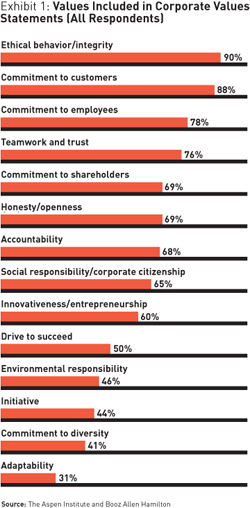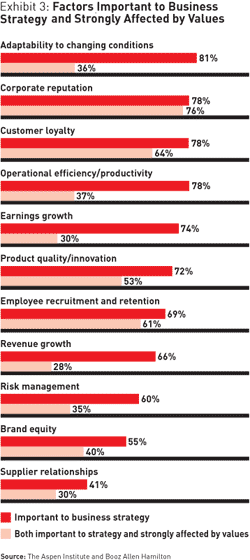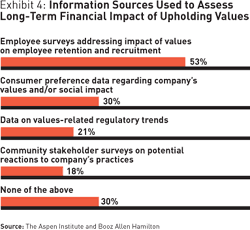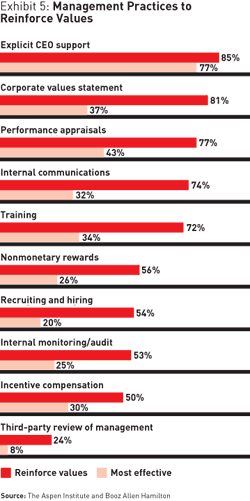The Value of Corporate Values
A Booz Allen Hamilton/Aspen Institute survey of corporate behavior finds that leading companies are crafting a purpose-driven identity.
 |
|
Illustration by Red Nose Studio |
Increasingly, companies around the world have adopted formal statements of corporate values, and senior executives now routinely identify ethical behavior, honesty, integrity, and social concerns as top issues on their companies’ agendas.
The meaning of this new emphasis on values, however, is less obvious than the trend itself. So to explore how deeply these values are embedded in organizations and to examine the role that values are playing, in 2004 Booz Allen Hamilton and the Aspen Institute, a nonprofit and nonpartisan forum focused on values-based leadership and public policy, conducted a global study of corporations in 30 countries and five regions. Senior executives of 365 companies were polled, almost one-third of whom were CEOs or board members. (See “Methodology” at the end of this article.) The purpose of the survey was to examine the way companies define corporate values, to expand on research about the relationship of values to business performance, and to identify best practices for managing corporate values.
The survey’s most significant finding was that a large number of companies are making their values explicit. That’s a change — quite a significant change — from corporate practices 10 years ago. The ramifications of this shift are just beginning to be understood.
At Xerox, CEO Anne Mulcahy says that corporate values “helped save Xerox during the worst crisis in our history,” and that “living our values” has been one of Xerox’s five performance objectives for the past several years. These values — which include customer satisfaction, quality and excellence, premium return on assets, use of technology for market leadership, valuing employees, and corporate citizenship — are “far from words on a piece of paper. They are accompanied by specific objectives and hard measures,” adds Ms. Mulcahy.
According to market and social trend analyst Daniel Yankelovich, the public’s widespread cynicism toward businesses today is the third wave of public mistrust about corporations in the past 90 years. The first, set off by the Great Depression, continued until World War II; the second, caused in part by economic stagflation and the Vietnam War, lasted from the early 1960s until the early 1980s. In each of these periods, Dr. Yankelovich wrote in the May 2003 report “Making Trust a Competitive Asset: Breaking Out of Narrow Frameworks,” companies tended to be reactive, blaming “a few bad apples,” dismissing values as “not central to what we do,” or ignoring opportunities to improve because “we don’t have to make major changes.”
The current wave of disapproval began in 2001 with the bursting of the dot-com bubble, the ensuing bear market, and the financial scandals involving Enron, WorldCom, Tyco, and others. But this time, according to the survey, the response appears to be different. More and more companies are looking inward to see what has gone wrong and looking outward for answers. They are questioning the quality of their management systems and their ability to inculcate and reinforce values that benefit the firm, its various constituencies, and the wider world. Rather than wall themselves off from critics, more companies are listening to them and looking for new ideas. And more firms are taking action to turn their corporation’s values into a competitive asset.
If the new attention to values were simply a transitory reaction to the business scandals of recent years, or merely a public relations device to direct or deflect media and investor attention, it would be worth little note. But more companies are going well beyond simply displaying values statements: They are engaging in values-driven management improvement efforts. Among those efforts are training staff in values, appraising executives and staff on their adherence to values, and hiring organizational experts to help address how values affect corporate performance.
Moreover, companies are showing little patience for executives who place their businesses at risk by crossing the line from prudent to unethical behavior. A recent example was the prompt decision by Boeing’s board to oust CEO Harry Stonecipher over a sexual affair he was having with an employee. Mr. Stonecipher had been appointed to the top job 15 months earlier to help improve Boeing’s standing with the Pentagon, its largest customer, after a series of ethics breaches. The board did not specifically indicate what ethical rule Mr. Stonecipher had violated, but it was clear that in the current climate, any obvious ethical lapse would be an indiscretion that the company could not tolerate and that would affect the bottom line. (See “CEO Succession 2004: The World's Most Prominent Temp Workers,” by Chuck Lucier, Rob Schuyt, and Edward Tse, Spring 2005.)
As Pfizer CFO David Shedlarz says in CFO Thought Leaders: Advancing the Frontiers of Finance (strategy+business Books, 2005): “It is critically important to do right. It is not adequate to meet the letter of the law — the spirit and the intent are what have to be kept keenly in mind.”
For the purposes of this study, we defined values as “a corporation’s institutional standards of behavior.” Generally, companies follow the same “values cycle”: They articulate a set of corporate values and attempt to embed them in management practices, which they hope will reinforce behaviors that benefit the company and communities inside and outside the firm, and which in turn strengthen the institution’s values.
The fundamental findings were:
• Ethical behavior is a core component of company activities. Of the 89 percent of companies that have a written corporate values statement, 90 percent specify ethical conduct as a principle. Further, 81 percent believe their management practices encourage ethical behavior among staff. Ethics-related language in formal statements not only sets corporate expectations for employee behavior; it also serves as a shield companies are using in an increasingly complex and global legal and regulatory environment.
• Most companies believe values influence two important strategic areas — relationships and reputation — but do not see the direct link to growth. Of the companies that value commitment to customers, 80 percent believe their principles reinforce such dedication. Substantial majorities also categorize employee retention and recruitment and corporate reputation as both important to their business strategy and strongly affected by values. However, few think that these values directly affect earnings and revenue growth.
• Most companies are not measuring their “ROV.” In a business environment increasingly dominated by attention to definable returns on specific investments, most senior executives are surprisingly lax in attempting to quantify a return on values (ROV). Fewer than half say they have the ability to measure a direct link to revenue and earnings growth.
• Top performers consciously connect values and operations. Companies that report superior financial results emphasize such values as commitment to employees, drive to succeed, and adaptability far more than their peers. They are also more successful in linking values to the way they run their companies: A significantly greater number report that their management practices are effective in fostering values that influence growth, and executives at these companies are more likely to believe that social and environmental responsibility have a positive effect on financial performance.
• Values practices vary significantly by region. Asian and European companies are more likely than North American firms to emphasize values related to the corporation’s broader role in society, such as social and environmental responsibility. The manner in which companies reinforce values and align them with company strategies also varies by region.
• The CEO’s tone really matters. Eighty-five percent of the respondents say their companies rely on explicit CEO support to reinforce values, and 77 percent say such support is one of the “most effective” practices for reinforcing the company’s ability to act on its values. It is considered the most effective practice among respondents in all regions, industries, and company sizes. (See “Leaders Make Values Visible,” below.)
|
Leaders Make Values Visible |
|
The corporate credo. Companies have wasted millions of dollars and countless hours of employees’ time agonizing over the wording of statements that are inscribed on plaques and hung on walls. There is a clear assumption that people’s behavior will change because the pronouncements on plaques are “inspirational” or certain words “integrate our strategy and values.” There is an implicit hope that when people — especially managers — hear great words, they will start to exhibit great behavior. Sometimes these words morph as people try to keep up with the latest trends in corporate-speak. A company may begin by striving for “customer satisfaction,” then advance to “total customer satisfaction,” and then finally reach the pinnacle of “customer delight.” But this obsession with words belies one very large problem: There is almost no correlation between the words on the wall and the behavior of leaders. Every company wants “integrity,” “respect for people,” “quality,” “customer satisfaction,” “innovation,” and “return for shareholders.” Sometimes companies get creative and toss in something about “community” or “suppliers.” But since the big messages are all basically the same, the words quickly lose their real meaning to employees — if they had any in the first place. Enron is a great example. Before the energy conglomerate’s collapse in 2001, I had the opportunity to review Enron’s values. I was shown a wonderful video on Enron’s ethics and integrity. I was greatly impressed by the company’s espoused high-minded beliefs and the care that was put into the video. Examples of Enron’s good deeds in the community and the professed character of Enron’s executives were particularly noteworthy. It was one of the most smoothly professional presentations on ethics and values that I have ever seen. Clearly, Enron spent a fortune “packaging” these wonderful messages. It didn’t really matter. Despite the lofty words, many of Enron’s top executives either have been indicted or are in jail. The situation couldn’t be more different at Johnson & Johnson. The pharmaceutical company is famous for its Credo, which was written many years ago and reflected the sincere values of the leaders of the company at that time. The J&J Credo could be considered rather quaint by today’s standards. It contains several old-fashioned phrases, such as “must be good citizens — support good works and charities — and bear our fair share of taxes” and “maintain in good order the property that we are privileged to use.” It lacks the slick PR packaging that I observed at Enron. Yet, even with its less-powerful language and seemingly dated presentation, the J&J Credo works — primarily because over many years, the company’s management has taken the values that it offers seriously. J&J executives have consistently challenged themselves and employees not just to understand the values, but to live them in day-to-day behavior. When I conducted leadership training for J&J, one of its very top executives spent many hours with every class. The executive’s task was not to talk about compensation or other perks of J&J management; it was to discuss living the company’s values. My partner, Howard Morgan, and I recently completed a study of more than 11,000 managers in eight major corporations. (See “Leadership Is a Contact Sport,” by Marshall Goldsmith and Howard Morgan, s+b, Fall 2004.) We looked at the impact of leadership development programs in changing executive behavior. As it turns out, each of the eight companies had different values and different words to describe ideal leadership behavior. But these differences in words made absolutely no difference in determining the way leaders behaved. One company spent thousands of hours composing just the right words to express its view of how leaders should act — in vain. I am sure that the first draft would have been just as useful. At many companies, performance appraisal forms seem to undergo the same careful scrutiny as credos. In fact, more effort seems to be given to producing the perfect words on an appraisal form than to managing employee performance itself. I worked with one company that had used at least 15 different performance appraisal forms and was contemplating yet another change because the present sheet “wasn’t working”! If changing the words on the page could improve the performance management process, every company’s appraisal system would be perfect by now. Companies that do the best job of living up to their values and developing ethical employees, including managers, recognize that the real cause of success — or failure — is always the people, not the words. Rather than wasting time on reinventing words about desired leadership behavior, companies should ensure that leaders get (and act upon) feedback from employees — the people who actually observe this behavior. Rather than wasting time on changing performance appraisal forms, leaders need to learn from employees to ensure that they are providing the right coaching. Ultimately, our actions will say much more to employees about our values and our leadership skills than our words ever can. If our actions are wise, no one will care if the words on the wall are not perfect. If our actions are foolish, the wonderful words posted on the wall will only make us look more ridiculous. Marshall Goldsmith (marshall@marshallgoldsmith.com) is a founder of Marshall Goldsmith Partners, and the author or coauthor of 18 books on leadership and coaching. His most recent book is Global Leadership: The Next Generation (Financial Times Prentice Hall, 2003). |
 License to Operate
License to Operate
In recent years, Booz Allen and the Aspen Institute noticed a marked increase in discussions about the principles that govern commercial enterprises. Both organizations also realized that more research was needed to systematically identify how companies define, apply, measure, and benefit from their corporate values, and how this varies by region. Our survey was an attempt to begin to fill the gaps between a growing practice and its results.
The survey found that 89 percent of respondents globally possess written values statements, and that nearly three-quarters believe that both executives and employees are under significant pressure to demonstrate strong corporate values. The vast majority of respondents’ corporate values statements — 90 percent — emphasize ethical behavior and integrity. This holds true whether the company is public or private, whether it is large or small, and regardless of its country of origin. (See Exhibit 1.)
Ethics-related language in formal statements has long been a priority for many business executives; in 1943, Johnson & Johnson promulgated its famed one-page Credo, which articulates the company’s “first responsibility” to “the doctors, nurses and patients, to mothers and fathers and all others who use our products and services,” as well as to “the men and women who work with us throughout the world,” “the communities in which we live and work and to the world community as well,” and “our stockholders.” The prevalence of ethics-related language today appears, though, to do more than set corporate expectations for employee behavior; it is, effectively, a part of a company’s license to operate in a more complex regulatory and legal environment.
The importance of these statements of belief has grown so quickly that many companies now can’t imagine doing business without them. “We’ve developed a set of values that everyone understands and that have real meaning,” says Lisa Colnett, human resources chief at Celestica, the Canadian electronics manufacturing company. “They are prescriptive and explicit and, at the same time, cover a wide range of stakeholders, including customers, employees, and shareholders. The point is, we are a global company and we want everyone to work together by the same sets of ethics and values to achieve the company’s goals.”
After ethics, the most prominent feature of corporate values statements is the set of values relating to company functions, rather than values that relate to the company’s broader role in society. Commitment to customers, for example, is nearly as prominent in values statements as ethics, and commitment to employees and teamwork/trust are not far behind, with each articulated by more than 75 percent of companies. Social responsibility/corporate citizenship is cited by two-thirds of respondents, but environmental responsibility and commitment to diversity are articulated by fewer than half.
Interestingly, some of the values often closely associated with revenue or earnings growth — such as initiative, adaptability, and innovativeness — appear in only 30 to 60 percent of the respondents’ formal values statements.
 But “financial leaders” are different. We asked respondents to self-identify financial leadership (exceptional business results), and then tested the results by scrutinizing financial statements for the publicly traded companies. Among these confirmed financial leaders, 98 percent include ethical behavior/integrity in their values statements, compared with 88 percent for other surveyed public companies. Far more of the financial leaders include commitment to employees (88 percent versus 68 percent), honesty/openness (85 percent versus 47 percent), and drive to succeed (68 percent versus 29 percent). Forty-two percent of the financial leaders emphasize adaptability in their values statements, compared with a mere 9 percent of other public companies.
But “financial leaders” are different. We asked respondents to self-identify financial leadership (exceptional business results), and then tested the results by scrutinizing financial statements for the publicly traded companies. Among these confirmed financial leaders, 98 percent include ethical behavior/integrity in their values statements, compared with 88 percent for other surveyed public companies. Far more of the financial leaders include commitment to employees (88 percent versus 68 percent), honesty/openness (85 percent versus 47 percent), and drive to succeed (68 percent versus 29 percent). Forty-two percent of the financial leaders emphasize adaptability in their values statements, compared with a mere 9 percent of other public companies.
There are also striking regional differences in the values companies emphasize, which we believe reflect differing traditions and expectations about business’s role in society. (See Exhibit 2.) Nearly three-quarters of Asia/Pacific firms include social responsibility/corporate citizenship in their values statements, followed by European firms at 69 percent. Only 58 percent of North American companies include social responsibility. Environmental responsibility also ranks significantly higher in Europe and Asia/Pacific than in North America. North American companies, however, are significantly more likely to cite ethical behavior than firms in Europe and Asia — a reflection, we believe, of both the recent attention to corporate scandals in the United States and media scrutiny of business in the U.S.
Of particular interest is the discovery that some of the values most closely linked to growth and performance and conventionally associated with American culture are more esteemed outside the U.S. For example, almost three-quarters of European companies value innovativeness and entrepreneurship; only half of U.S. companies articulate this principle — a counterintuitive finding that should prompt introspection among American executives.
Values in Action
The last three years have seen a relentless succession of stories about the harm companies and their shareholders have suffered from ethical breaches and noncompliance with regulatory standards and legal norms. Billion-dollar fines, protracted lawsuits, criminal convictions of executives, severely tarnished corporate reputations — even the evaporation of large companies — have become distressingly familiar. Given the frequency and notoriety of the scandals, it is perhaps not a surprise that a huge segment of the respondents believe that articulated values are essential to mitigating legal and regulatory risk. Ninety percent agree that a strong corporate statement addressing ethical values is critical in encouraging individual employees to take appropriate actions and to inform their managers when something seems wrong. Eighty-one percent say they have management practices in place that are “considerably effective” or “very effective” in fostering ethical behavior and integrity among individuals.
However, the benefits of corporate values transcend legal and regulatory compliance. We asked executives to specify the factors that are important to their business strategy, and also to pinpoint which of those factors can be affected positively by the active management of values. Their responses show clearly that values are deemed most critical in two strategic areas: reputation and relationships. Strong brand equity and the overall standing of the company correlate highly with a commitment to corporate values. So does the robustness of the firm’s associations across its extended enterprise, from suppliers to employees to customers. (See Exhibit 3.)
 Although previous studies have shown a strong relationship between values-based management and risk management, our findings were ambiguous. The lack of awareness by companies of the relationship between values and risk management is puzzling. In recent years, companies around the world have understood and acted on risks that exist outside the traditional confines of financial risk and operating risk. Today, firms spend abundantly to protect against reputation risk; the “war for talent” among companies has made them aware of the importance of their work forces, their capabilities, and worker replacement costs — another form of risk. Recent client work by Booz Allen demonstrates that risk management is important both in protecting against potential problems and in taking advantage of opportunities. Of the top 20 enterprise risks measured on shareholder-value impact in one recent case, more than half involved corporate reputation; brand; or relationships with suppliers, customers, and employees — all elements that companies in this survey cited as being strongly affected by values. In light of the massive shareholder destruction that has taken place over the last several years, we find it troubling that more companies do not recognize the existence of the relationship between articulated values and risk management.
Although previous studies have shown a strong relationship between values-based management and risk management, our findings were ambiguous. The lack of awareness by companies of the relationship between values and risk management is puzzling. In recent years, companies around the world have understood and acted on risks that exist outside the traditional confines of financial risk and operating risk. Today, firms spend abundantly to protect against reputation risk; the “war for talent” among companies has made them aware of the importance of their work forces, their capabilities, and worker replacement costs — another form of risk. Recent client work by Booz Allen demonstrates that risk management is important both in protecting against potential problems and in taking advantage of opportunities. Of the top 20 enterprise risks measured on shareholder-value impact in one recent case, more than half involved corporate reputation; brand; or relationships with suppliers, customers, and employees — all elements that companies in this survey cited as being strongly affected by values. In light of the massive shareholder destruction that has taken place over the last several years, we find it troubling that more companies do not recognize the existence of the relationship between articulated values and risk management.
Financial leaders appear to be doing a better job than other companies in linking corporate values to corporate operations. For example, nearly all financial leaders (94 percent) say they have practices in place to ensure that their values are aligned with those of their suppliers, distributors, and partners, whereas only 64 percent of other public companies do. Financial leaders are also significantly more likely to report that their management practices are effective in fostering a variety of behaviors related to better business performance — including the core operating behaviors that influence growth. Seventy-five percent, for example, say their management practices are very effective in encouraging teamwork and trust, compared with fewer than half of the other public companies. About 60 percent of the financial leaders say their practices are very effective in promoting initiative, adaptability, and innovativeness/entrepreneurship, compared with about 30 percent for the other public companies.
Financial leaders also believe social responsibility and environmental responsibility have a positive financial impact. Nearly half (49 percent) believe that environmental responsibility has a positive impact on financial performance in the short run, compared with 34 percent for the other public companies. Sixty-six percent of financial leaders see a positive short-term impact from social responsibility, compared with 54 percent for other public companies.
Measuring Return
It’s possible that a majority of companies have difficulty connecting values to operational results because values such as honesty/openness, initiative, and entrepreneurship seem intangible. Even the most advanced nonfinancial measurement tools are still quite limited in their ability to show a clear connection between principles, such as trust, and business goals, such as adaptability, efficiency, and growth in revenue and earnings.
 More than two-thirds of companies report that they collect some form of information for assessing the long-term financial impact of upholding values. However, there is little commonality among these companies as to the type of information collected. (See Exhibit 4.)
More than two-thirds of companies report that they collect some form of information for assessing the long-term financial impact of upholding values. However, there is little commonality among these companies as to the type of information collected. (See Exhibit 4.)
Measurement is most commonly used to assess how values affect employee retention and recruitment: More than half of respondents indicate that their companies address the issue by employee satisfaction surveys. However, many such surveys are limited in their scope, measuring only satisfaction, and missing the opportunity to measure the degree to which values are embedded in everyday action. As a result, such surveys may be failing to capture important information about people, performance, and strategy.
Indeed, metrics are distinguished more by what is missing than by what is present. Even activities that respond well to values-based management are infrequently measured. For example, although nearly two-thirds of respondents agree that values can strongly affect customer loyalty, far fewer actually measure their customers’ attitudes toward and perceptions of their values. Fewer than one-third of companies use consumer preference data regarding their company’s values and/or social impact. And in their strategic planning process, fewer than one-quarter use customer preference models to assess the impact of upholding corporate values.
 Practice Makes Perfect
Practice Makes Perfect
How do companies align values and strategy? In other words, which management practices reinforce values in the organization and which factors enable executives to make decisions consistent with their corporate values? Our survey shows that the behavior of the chief executive officer is critical.
Eighty-five percent of the respondents say their companies rely on explicit CEO support to reinforce values, and 77 percent say CEO support is one of the “most effective” practices for reinforcing the company’s ability to act on its values. (See Exhibit 5.) It is the leading choice across geographies and industries, regardless of company size. In contrast, although a substantial majority of the respondents say they use practices such as corporate values statements, performance appraisals, internal communications, and training to reinforce values, fewer than half call these practices the “most effective.”
Why do companies continue to employ these practices if they are not as effective as CEO support? Like any other business objective, successful management of values cannot be executed through a strong top leader alone; it also requires a “virtuous circle” of management where dispersed leadership, strategy, practice, and measurement are mutually reinforcing.
For example, although only 37 percent of companies see a values statement as one of the “most effective” practices in and of itself, 81 percent still feel the need for such a statement, in part because it is the basis for reinforcing other, sometimes more important, practices. (For a chief executive to show explicit support for the company’s values, for example, it helps to have a values statement to which the CEO can refer.) Similarly, if performance appraisals nominally include values, but there is no senior support behind them, then they are likely to be empty words on a piece of paper. And if the CEO is communicating a set of values, but performance appraisals undermine his or her message, the CEO’s communication is less effective.
Regional variations on the factors that help align practices and values are significant, although globally, two top the list: the behavior of the company’s CEO, and corporate strategy itself. In North America, it’s personal. Seventy-three percent of respondents in the U.S. and Canada say that “my personal values system” is a primary enabler for aligning values with decision making, compared with 60 percent who cite corporate strategy. Beyond these enabling factors, no factors score higher than 40 percent among North American respondents.
In Europe and Asia/Pacific, only 47 percent and 35 percent, respectively, select “my personal values system” as one of the top five factors enabling decision making consistent with corporate values. Among Asian companies, values-based decision making is driven much more by corporate strategy (78 percent) and customer demand (53 percent) than is the case at companies in North America and Europe.
As for factors that inhibit the alignment of values and management decisions, one stands out. Among financial leaders, fewer than one-third say short-term economic costs hinder alignment with values; among other public companies, however, more than half are deterred by the short-term costs.
Embracing Opportunity
Our survey shows that values are seen by the corporation as a critical component of establishing its license to operate. However, the research suggests that while the logic in relating values-based management to business performance has a strong following among executives around the world, the management practices and measurement techniques related to the values are works in progress at most companies. Specifically, there seems to be a lack of recognized “best practices” in establishing linkages between values and both long-term strategic goals and shorter-term results. There is also relatively little agreement on what works and what doesn’t work, both in aligning values with strategy and in embedding values in management processes.
Executives generally see the impact of values on important strategic objectives relating to corporate reputation and relationships, as well as to product quality. However, most have a harder time seeing how values directly affect the top and bottom lines. This is not surprising, because business has always had a hard time dealing with intangibles. Consider, for instance, the decades’ worth of discussion, academic debate, and trial and error that have gone into defining and measuring the returns on investment in brand, research and development, and training. In the same way that techniques have been developed to measure the returns on these intangibles, leading companies are beginning to develop ways to measure the return on values.
The study does show that companies that can be called financial leaders have come further in understanding the relationships between values and performance, that they are doing a better job of exploiting them, and that their more comprehensive approach to values is associated with superior financial performance. This suggests that, although all companies may be convinced that values are important for avoiding risks, many have yet to discover how to use them to grasp opportunities. It also suggests that there is substantial scope for identifying a set of best practices that may some day enable all companies to better measure and align their values with their strategies.
So the next set of imperatives is for business leaders to move from talking about values and viewing them defensively to embracing them in order to drive corporate performance and change — and for executives at companies that have figured out the linkages to do a better job of demonstrating their success. Consumers, investors, and other constituencies become leery of corporate imperatives that don’t deliver demonstrable results, and corporate values are no exception. A commitment to corporate values may be in vogue, but the public will remain suspicious until corporations both understand and can demonstrate that they are committed to using values to create value.![]()
|
“By making values fundamental to your organization...you can reduce risks in most situations.” |
|
The British mobile telecommunications company Vodafone views its commitment to values as a first line of defense against risk. The company believes in four primary values: “passion for customers,” “passion for our people,” “passion for results,” and “passion for the world around us,” underpinned by acommitment to six primary business principles. More than any set of systems or processes, these rules of behavior can protect a company from harmful incidents that could potentially damage performance or reputation, says Vodafone director Devin Brougham. “By making values fundamental to your organization... you can reduce risks in most situations,” Mr. Brougham says. “If you don’t have a culture of ethical decision making to begin with, all the controls and compliance regulations you care to deploy won’t necessarily prevent ethical misconduct.” The challenge is to ensure that these values take hold. “Training, senior management advocacy, and values-focused performance evaluation are all part of our approach,” says Mr. Brougham. “And importantly, our employees have a clear understanding of working in this expected framework.” |
|
“Values are the key to making money.” |
|
Martin Carver, CEO of Bandag Inc., a retread tire company based in Muscatine, Iowa, says that “values are the key to making money,” but only if a company truly takes values seriously. Not enough do, he adds. “Loads of companies will tell you they have values,” Mr. Carver says. “More than likely they’ve got their values plastered all over the walls. But very few companies clearly see the correlation between success and values, so they never really embrace, define, and then drive them into the organization with any real passion.” Many companies use Six Sigma techniques to achieve quality, adds Mr. Carver, but “without a foundation of trust, ethics, and genuine statements of and commitment to core values, you just can’t design real quality into your processes. We can point to the our commitment to a clearly defined set of beliefs delivers a positive impact to our business, our employees, our customers, the local community, and the world.” |
|
“I see the value of values every day.” |
|
France’s Bongrain, one of the world’s largest cheese companies, doing business in 100 countries, is convinced that the importance of good values to a company’s performance cannot be overestimated. “I see the value of values every day,” says division head Thomas Swartele. “The communication, the innovation, the adaptability, the coherence: Those are the value of values. Because you are approaching markets, problems, and business opportunities from a shared basic belief system, a values-based business approach becomes extremely efficient and powerful.” This is best illustrated by Bongrain’s relationships with its suppliers. The company sells premium foods, and it requires the highest quality in all of the products that it purchases from local farmers around the world. As a result, the company forms close partnerships with these suppliers, collaborating on such issues as livestock diet and feed and housing conditions. “These are living products, and the slightest variations can have a dramatic impact on quality,” says Mr. Swartele. “Our approach might cost a bit more, but it not only satisfies our values, it helps us to achieve the quality that justifies the higher margins that we want in the business.” Ultimately, adds Mr. Swartele, “Our success is tied to their success.” |
|
Methodology |
|
Booz Allen Hamilton and the Aspen Institute invited approximately 9,500 senior executives from around the world to participate in this global study. The objective of our research was to understand how companies are dealing with the challenges of managing values:
Phase One of the invitation process involved the mailing of 8,000 English and Japanese invitations and surveys in early July 2004. Phase Two included the mailing of 300 German, 750 Chinese, and 400 supplemental Australian invitations. These findings reflect the 365 completed surveys received (both in print and on the Web), which represent a 3.5 percent response rate (net of undeliverables). In October and November 2004, we conducted phone interviews with 20 of the individuals who responded to the survey, all C-level executives from major multinational corporations. Our respondents are predominantly from large companies based in North America, Europe, and the Asia/Pacific region. Half of these respondents (47 percent) are based in North America, 27 percent represent companies based in Europe, and 24 percent represent companies based in the Asia/Pacific region. One-fourth of the respondents are from companies with annual revenues exceeding US$10 billion. One in six (16 percent) are from companies with annual revenues between US$5 billion and $9.9 billion. One in four (25 percent) are from companies with between US$1 billion and $4.9 billion in revenues, and another 25 percent are from companies with revenues under US$500 million. The remaining 10 percent are from companies with revenues between US$500 million and $999 million. More than three-quarters of the respondents are top leaders in their companies. CEOs and managing directors make up nearly a fourth of the sample (24 percent), with other C-level executives (CFO, COO, CAO, chief ethics officer, or CHRO) accounting for another 22 percent of the sample. Board members represent an additional 7 percent of the sample. General managers and heads of departments and divisions make up 32 percent of the sample. Risk management and general counsel respondents comprise 5 percent of the sample. Ten percent of respondents classified their job function as “other.” Respondents represent many industries: financial services and manufacturing lead at 26 percent and 25 percent, respectively, followed by consumer-related companies (including consumer products, media, and retail) and technology (including both technology hardware/ equipment and telecommunications), each at 11 percent. Utilities (7 percent), transportation (7 percent), and energy (5 percent) make up the balance, along with 8 percent in miscellaneous or unclassified industries. Financial leaders in this report are those companies that categorized themselves as leaders in their industries and whose publicly reported financial results for the past three years were at least 10 percent ahead of those of industry competitors. We compared the survey responses of this group of financial leaders with the responses of other public companies. |
Reprint No. 05206
Reggie Van Lee (van_lee_reggie@bah.com) is a senior vice president with Booz Allen Hamilton in New York. He has extensive experience in developing and implementing major growth strategies and change programs for media and high-tech companies.
Lisa Fabish (fabish_lisa@bah.com), who is based in Booz Allen Hamilton’s McLean, Va., office, has extensive experience working with clients to identify strategic risks through wargaming and scenario-based planning.
Nancy McGaw (nancy.mcgaw@aspeninstitute.org) is deputy director of the Aspen Institute’s Business and Society Program, which is based in New York. She directs the program’s research projects on corporate leadership and trends in management education.
Also contributing to this article were Booz Allen Senior Vice President Paul Kocourek and Vice President Chris Kelly; Judith Samuelson, executive director of the Aspen Institute’s Business and Society Program; Ann Graham, deputy editor of strategy+business; and Julien Beresford, president of the Beresford Group research company.



